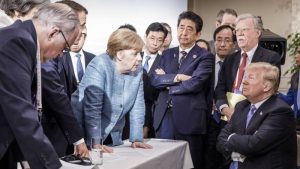
The above has become the iconic image of Trump with other allied leaders. For some time, now, the ‘Experts’ have been trying fully to capture the core, and the operating mechanics of Trump foreign policy.
This started before Trump’s surprise election. It has continued on since that time. Understanding Trump’s foreign policy and his various initiatives have become rather more critical as time goes on. We see Trump and his close colleagues trying to advance Trump policy at the regular summits, most evidently the G7 (the picture above); at summits of his own making most notably the Singapore Summit with North Korea’s leader Kim Jong Un, and a soon to be convened NATO Summit to followed by Trump’s meeting with Vladimir Putin of Russia in Helsinki.
So where are we? And where is Trump leading? Describing Trump foreign policy means an effort to capture what Trump means by his ‘America First’ strategy. It seemed early on that America First was built on a foundation of some form of U.S. unilateralism and strong skepticism over the multilateral institutions in trade and political alliances that served as the heart of the liberal international order. Most of us saw the irony of this: after all the United States had been the chief promoter and ‘construction boss’ for building the liberal international order. As our colleague John Ikenberry declared in FA in his article, “The Plot Against American Foreign Policy”, there is yet another irony:
A hostile revisionist power has indeed arrived on the scene, but it sits in the Oval Office, the beating heart of the free world. Across ancient and modern eras, orders built by great powers have come and gone—but they have usually ended in murder, not suicide.
There was some degree contention by analysts to assess what degree of aggressiveness – how forward or uninvolved – Trump foreign policy would be. This assessment was not so much against America’s rivals but with America’s allies. As time has passed though, it seems there is a growing sense that Trump is mounting a serious, even concerted effort to dismember the liberal order.
Bob Kagan at Brookings has provided an analysis that suggests, as the French would say, a strategy ‘a outrance’ for Trump’s aggressive approach. As Kagan argued in “Trump’s America does not care”:
It turns out there was a third option: the United States as rogue superpower, neither isolationist nor internationalist, neither withdrawing nor in decline, but active, powerful and entirely out for itself.
There appears to be a growing acknowledgement that Trump policy is actively order-dismantling. It is worth reaching back to one of the first articles to chronicle Trump foreign policy. This assessment is by our colleague Tom Wright, again at Brookings, early in 2016 in his article in Politicomagazine.
In sum, Trump believes that America gets a raw deal from the liberal international order it helped to create and has led since World War II. He has three key arguments that he returns to time and again over the past 30 years. He is deeply unhappy with America’s military alliances and feels the United States is overcommitted around the world. He feels that America is disadvantaged by the global economy. And he is sympathetic to authoritarian strongmen. Trump seeks nothing less than ending the U.S.-led liberal order and freeing America from its international commitments. (Emphasis added)
Trump’s policy found echoes, according to Wright, in early twentieth century American foreign policy. Wright describes some of the similarities between Trump and Republican Presidential candidate Robert Taft (Taft ran in 1940, 1948 and 1952) that Wright describes as an “staunch isolationist and mercantilist” who according to him, “Taft’s speeches are the last time a major American politician has offered a substantive and comprehensive critique of America’s alliances.
So, now it seems that IR experts are called on to go further than many expected. We need to describe the path of this dismantling and the consequences for international relations of such an extreme American foreign policy. Our colleague Amitav Acharya at American University recently wrote in EastAsiaForum that the future is not likely to correspond to the “doomsday scenarios of disarray and collapse” that have been expressed by what he calls, the “liberal pundits of the West”. Here is what he sees:
Instead of helping the West to resurrect the liberal order, Asia will lead the transition to a different type of world order. The remnants of the liberal order will have to come to terms with a Chinese-led order and other regional orders around the world in what I call a decentered and post-hegemonic ‘multiplex world.
Maybe, but maybe disarray is not so far off the mark. Let’s examine the upcoming summits.
Image Credit: Jesco Denzel/German Federal Government, via Reuters

